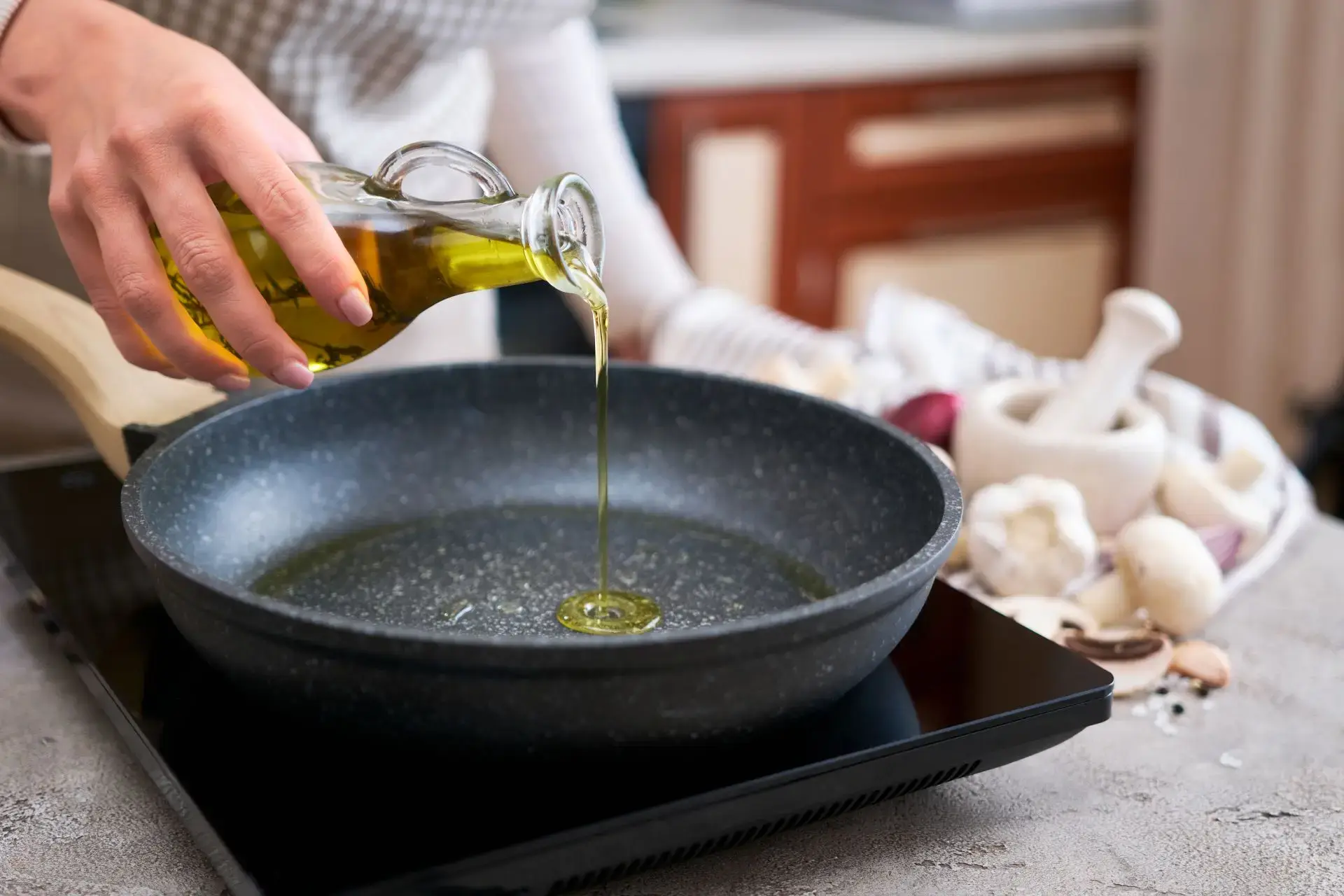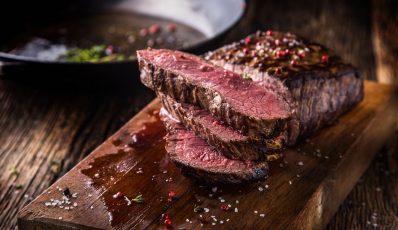Choosing the right frying oil can influence the flavour and texture of dishes, their nutritional value, and their impact on your health. With so many oils on the shelf, each with its strengths and weaknesses, figuring out which one to use can feel overwhelming. In this article, we'll guide you on choosing the right oil for different uses. We'll also explain how the smoke point of oil affects the cooking process.

Choosing the right frying oil can influence the flavour and texture of dishes, their nutritional value, and their impact on your health. With so many oils on the shelf, each with its strengths and weaknesses, figuring out which one to use can feel overwhelming. In this article, we’ll guide you on choosing the right oil for different uses. We’ll also explain how the smoke point of oil affects the cooking process.
Not All Oils Are Created Equal
The choice of frying oil is crucial both for the quality of the dishes prepared and for your health. One of the most important factors is the smoke point of the oil—the temperature at which the oil begins to smoke and break down, forming harmful to health compounds. Using oil with a too-low smoke point at a high frying temperature can lead to the formation of free radicals and carcinogenic substances.
Moreover, oils have different flavor profiles and nutritional values that can affect the texture, taste, and nutritional value of a dish. For example, some oils are rich in unsaturated fatty acids, which are beneficial for the heart but may be less stable when frying. Others, containing more saturated fatty acids, may withstand high temperatures better but are less beneficial for cardiovascular health.
Types of Frying Oils
The market offers various types of oils, each characterised by unique flavour, nutritional, and thermal properties. Here’s an overview of the most popular oils used for frying:
Olive Oil is known for its health benefits due to its high content of monounsaturated fatty acids. Extra virgin olive oil has a relatively low smoke point, making it best for cooking at low to medium temperatures, but there are also refined versions that can withstand higher temperatures.
Coconut Oil has a high smoke point and is rich in saturated fatty acids, making it stable at high temperatures. Coconut oil adds a mild, tropical flavour to dishes, which can be an additional advantage depending on the type of dish prepared.
Canola Oil is often chosen for its neutral flavour and high smoke point. It is also rich in omega-3 fatty acids, making it a healthier option for those concerned about heart health.
Sunflower Oil is popular due to its neutral taste and high smoke point. Available in versions containing high concentrations of oleic acids, which are more resistant to high temperatures.
Peanut Oil is characterised by a very high smoke point, making it ideal for deep frying. It has a subtle nutty flavour that can enhance the taste of fried foods.
Sesame Oil is valued both for its health benefits and unique, intense flavour. Rich in antioxidants and healthy monounsaturated and polyunsaturated fatty acids, sesame oil is used both in its raw form and for cooking. However, it is important to distinguish between the two main types of sesame oil: light (refined), which has a higher smoke point and is better for frying, and dark (unrefined), which is mainly used for flavouring finished dishes due to its lower smoke point and more intense flavour.
Soybean Oil has a high smoke point, making it ideal for various cooking techniques, including deep-fat frying. Soybean oil has a very neutral taste and does not significantly affect the flavour of prepared dishes.
Avocado Oil – One of the best options for frying at high temperatures due to its very high smoke point. Avocado oil is also rich in heart-healthy monounsaturated fats and vitamin E.
The Healthiest Frying Oil
Choosing the healthiest frying oil can significantly impact the quality of your diet and overall health. Some oils, like avocado oil, rich in monounsaturated fats and vitamin E, are an excellent choice for frying. Other healthy options include macadamia nut oil and peanut oil, which also withstand high temperatures and provide valuable monounsaturated fats and vitamin E. Canola oil also contains beneficial omega-3 and omega-6 fatty acids. Refined sesame oil and high-oleic sunflower oil are stable at high temperatures and provide healthy fats. When selecting an oil, consider not only its smoke point but also its fatty acid profile and potential health benefits.
-
Electric Deep Fryer – 6 Litres with Drain Tap
169.00 €159.00 € -
Electric Deep Fat Fryer – 1 x 10 litres 169.00 €
-
Electric Deep Fryer – 1 x 10 litres – ECO 99.00 €
-
Electric deep fryer – 8 L – 230 V 119.00 €
Parameters to Consider When Choosing a Frying Oil
Choosing the right frying oil depends on several key factors you should consider:
Smoke Point – This is one of the most important criteria when selecting a frying oil. Oils with a high smoke point are more stable at high temperatures, and therefore less likely to produce harmful compounds during cooking. Oils with a low smoke point decompose more quickly, which can lead to the formation of harmful substances.
Fatty Acid Composition – Different types of fats react differently to heat. Oils rich in unsaturated fatty acids, such as olive oil or canola oil, are better for heart health but may be less stable at high temperatures compared to oils containing more saturated fats, such as coconut or palm oil.
Flavour – Some oils have a distinctive, characteristic flavour that can influence the taste of ready dishes. For instance, sesame oil or coconut oil bring their unique flavour notes, which may be desirable in certain dishes.
Nutritional Values – Beyond fatty acid composition, some oils also provide additional nutritional values, such as vitamins and antioxidants.
Special Applications of Frying Oils
Cooking oils have a wide range of uses that go beyond traditional frying and cooking, enriching the culinary repertoire both in terms of flavour and cooking techniques. Sesame oil, popular in Asian cuisine, adds depth of flavour to dishes, especially when used as an addition to dressings and marinades. Its strong, distinctive aroma makes it perfect for salads and dishes fried at low heat. Meanwhile, coconut oil, with its mild, tropical flavour, is excellent for baking and as an ingredient in vegan desserts, replacing traditional fats like butter. Additionally, coconut oil can be used in fryers, allowing for healthier preparation of dishes requiring deep frying. Canola or sunflower oils, thanks to their high smoke points, are ideal for use in fryers, where their thermal stability allows for efficient and safe frying.
-
Donut Fryer – 18 litres – 3,200 W – cold zone 179.00 €
-
Donut Fryer – 30 litres – 9,000 W – cold zone 519.00 €
-
Double pastries deep fat fryer – 33 L – 400 V – 2 Baskets 449.00 €
-
Donut Fryer – 23 L – Royal Catering – 230 V
389.00 €299.00 €
How to Choose the Best Oil for Different Types of Dishes?
Choosing the best oil for different types of dishes can influence their taste, texture, and nutritional values. Here are some tips on how to select oils depending on your culinary needs:
Deep Fat Frying – For deep-fat frying, it is important to use oils with a high smoke point. Oils such as canola, sunflower, or peanut oils are ideal, as they are stable at high temperatures and have a neutral taste that does not overpower the flavour of the dishes.
High-Temperature Frying – When frying or grilling at high temperatures, thermally stable oils such as avocado oil, macadamia nut oil, or refined sesame oil are best.
Salads and Dressings – For salads and dressings, it is best to choose cold-pressed oils, which offer full flavour and nutritional values. Extra virgin olive oil, flaxseed oil, or grape seed oils perfectly accentuate the taste of fresh ingredients and are rich in beneficial fats.
Gentle Frying and Simmering – For frying at lower temperatures or simmering, the best options are oils with a medium smoke point and rich in nutrients. Coconut oil, olive oil, or even clarified butter can enhance the flavour of dishes without the risk of burning.
Bakery and Desserts – For baking cakes, cookies, or bread, it’s worth using oils that add moisture and flavour, such as coconut oil or walnut oil. These oils not only improve the texture of baked goods but can also introduce additional flavour notes.
How to Store Oil?
Proper storage of frying oil is crucial for preserving its freshness, flavour, and nutritional value. Here are some practical tips:
Avoid Light and Heat – Store oil in a cool, dark place, away from direct sunlight and heat sources such as stoves or heaters. Light and heat accelerate the oxidation process, leading to oil spoilage.
Use Suitable Containers – It is best to store oil in tightly sealed, dark glass bottles or metal containers that do not allow light to pass through. Avoid plastic bottles, which can react with the oil, especially if they are exposed to light.
Monitor Expiry Dates – Always check the expiry dates on packages and do not use oil that appears to be past its date.
Do Not Overheat the Oil – Avoid repeatedly heating the oil. Each subsequent heating reduces the quality of the oil and increases the amount of unhealthy compounds.
Protection from Contaminants – Try not to introduce contaminants into the oil container, using clean tools to scoop the oil. Contaminants can accelerate the spoilage process of the oil.
How Many Times Can You Reuse Frying Oil?
This depends on several factors, including the type of oil used, the frying temperature, and the type of fried products. Here are some tips to help you assess when to replace the oil:
Type of Oil: Oils with a high smoke point, such as canola, sunflower, or peanut oils, are more resistant to high temperatures and can be used for frying several times. Oils with a lower smoke point, like olive oil, decompose more quickly and are not suitable for multiple uses.
Frying Temperature: The higher the temperature, the faster the oil degrades. Frying at a moderate temperature can help extend the life of the oil.
Type of Fried Products: Breaded products or those that release a lot of water during frying can cause the oil to deteriorate more quickly.
Smell and Colour: If the oil starts to smell unpleasant or changes colour to a significantly darker shade, it is a sign that it may be unhealthy and should be replaced.
In general, oil in a fryer can be used 2-3 times. It is important to regularly check the condition of the oil and filter it after each use to remove food residues, which can accelerate the spoiling process. If you are unsure whether it is still suitable for further use, it is better to discard it and use fresh oil.






Share